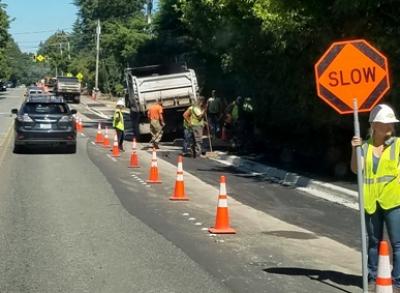Street Resurfacing
Arterial Street Programs
The arterial street improvement program provides for the resurfacing and upgrade of Mercer Island's 26 miles of arterial streets on an approximate 25 year cycle. In general, one arterial street improvement is constructed each year. Typically, major pedestrian and bicycle facility improvements are constructed in conjunction with arterial improvements for cost efficiency.
Residential Street Programs
The program also resurfaces and upgrades approximately 52 miles of residential streets on a 35 year cycle. It is difficult to plan residential overlay projects too many years in advance due to their ever-changing conditions, impacts from large-scale home construction, and the effects of ongoing water and sewer system improvements on street conditions.
How Are Street Projects Prioritized?
The City's Street Engineer performs a street pavement condition survey every three years using an outside contractor with custom-equipped vehicles. This survey serves as a tool to rank all City-owned and maintained streets based on their current condition. Wondering when your street was last resurfaced? -- look for the most recent summary map on the Transportation Improvement Program page. The Island's streets wear at different rates based on a variety of factors: currently, the arterial street network is on an approximate 25 year life cycle for resurfacing or reconstruction, and the residential streets are on a 35 year cycle. The results of the survey help determine the priority of future street improvements, and pavement condition ratings rank streets on a 100-point scale, with excellent streets rated at 100 and failed streets rated at zero (see maps below). The survey uses five criteria to determine the pavement condition rating:
- Visible Pavement Distress: Cracks, potholes, settlement, and pavement patches.
- Pavement Base: Ability of the soil or gravel foundation to support the pavement and traffic load.
- Surface Condition: Condition of the pavement surface.
- Drainage: Poor drainage can result in premature base/surface failures, reducing pavement life.
- Traffic Volume: High traffic volume wears surfaces more rapidly and will accelerate the growth of pavement distress.
Other factors, such as utility improvement schedules, the need for drainage improvements, sequencing with other street work, and long range planning are then considered before developing a final street improvement program. Residential street overlays are also linked, where feasible, to arterial street projects to create an economy of scale by performing more road improvements under one large contract.
What Streets Will Be Improved In The Future?
Streets with higher traffic volumes and with vehicles carrying heavy loads (typically arterial streets), will deteriorate more quickly than less traveled streets. Weather (rain, extreme heat or cold) can greatly affect pavement performance. In addition, the base material and underlying soil supporting the roadway, the type of pavement (concrete versus asphalt) and the age of pavement all play a part in how long the pavement surface will last. Industry standard suggests that an average pavement life is 18 years before there is a significant drop in condition.
The City makes its decisions using the Transportation Improvement Program (TIP) - a rolling 6-year plan updated annually with a focus on maintaining the existing transportation network and improving it in a thoughtful, safe manner working within the financial constraints of the Street Fund and other funding sources. The TIP covers City roadway projects, but also pedestrian, bicycle and other transportation projects, and is approved by the City Council.

